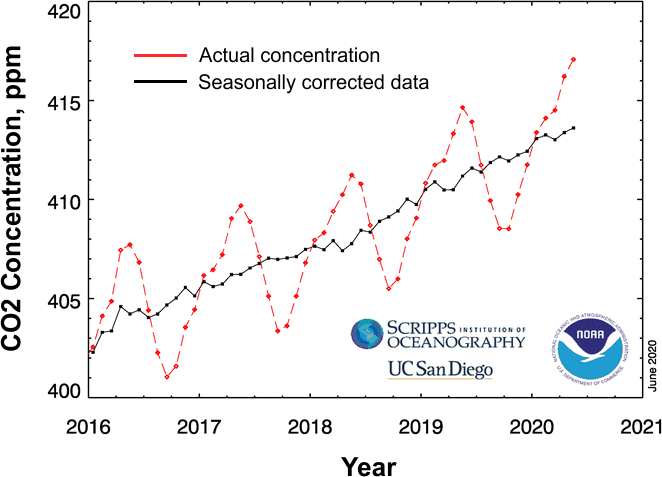Rise of atmospheric CO2 concentrations unabated by Covid-19
8 June 2020
Atmospheric carbon dioxide measured at Mauna Loa Observatory in Hawaii reached a seasonal peak of 417.1 ppm for 2020 in May, the highest monthly reading ever recorded, according to data collected by the US National Oceanic and Atmospheric Administration (NOAA).

This year’s peak value was 2.4 ppm higher than the 2019 peak of 414.7 ppm recorded in May 2019. Monthly CO2 values at Mauna Loa first breached the 400 ppm threshold in 2014, and are now at levels not experienced by the atmosphere in several million years.
The rate of atmospheric CO2 increase during 2020 does not appear to reflect the reduction in emissions due to the sharp, worldwide economic slowdown in response to the Covid-19 pandemic. The reason is that the drop in emissions would need to be large enough to stand out from the large natural CO2 variability, caused by how plants and soils respond to seasonal and annual variations of temperature, humidity, soil moisture, etc. If emissions reductions of 20 to 30% were sustained for six to 12 months, then the rate of increase of CO2 measured at Mauna Loa would be slowed, said NOAA.
The rate of CO2 increase in the atmosphere has been steadily accelerating. In the 1960s, the annual growth averaged about 0.8 ppm per year. It doubled to 1.6 ppm per year in the 1980s and remained steady at 1.5 ppm per year in the 1990s. The average growth rate again surged to 2.0 ppm per year in the 2000s, and increased to 2.4 ppm per year during the last decade. The largest year-to-year increase of 3.05 ppm was recorded in 2015. “There is abundant and conclusive evidence that the acceleration is caused by increased emissions,” said Pieter Tans, senior scientist with NOAA’s Global Monitoring Laboratory.
Source: NOAA